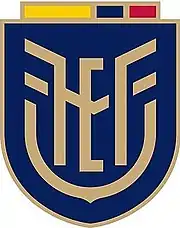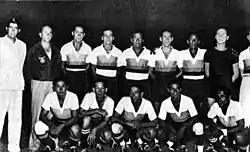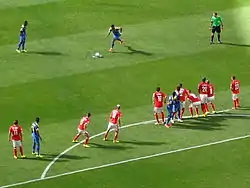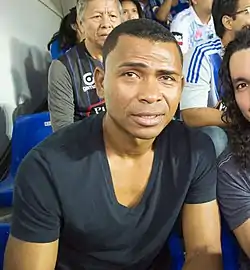Ecuador national football team
The Ecuador national football team (Spanish: Selección de fútbol de Ecuador) has represented Ecuador in men's international football since 1938 and is controlled by the Ecuadorian Football Federation (Federación Ecuatoriana de Fútbol). They joined FIFA in 1926 and CONMEBOL a year later.
 | ||||||||||||||||||||
| Nickname(s) | La Tri (The Tri) La Tricolor (The Tricolors) | |||||||||||||||||||
|---|---|---|---|---|---|---|---|---|---|---|---|---|---|---|---|---|---|---|---|---|
| Association | Federación Ecuatoriana de Fútbol (FEF) | |||||||||||||||||||
| Confederation | CONMEBOL (South America) | |||||||||||||||||||
| Head coach | Gustavo Alfaro | |||||||||||||||||||
| Captain | Enner Valencia | |||||||||||||||||||
| Most caps | Iván Hurtado (168) | |||||||||||||||||||
| Top scorer | Agustín Delgado Enner Valencia (31) | |||||||||||||||||||
| Home stadium | Estadio Rodrigo Paz Delgado | |||||||||||||||||||
| FIFA code | ECU | |||||||||||||||||||
| ||||||||||||||||||||
| FIFA ranking | ||||||||||||||||||||
| Current | 56 | |||||||||||||||||||
| Highest | 10 (July 2012) | |||||||||||||||||||
| Lowest | 71 (November 2017) | |||||||||||||||||||
| First international | ||||||||||||||||||||
(Bogotá, Colombia; 8 August 1938) | ||||||||||||||||||||
| Biggest win | ||||||||||||||||||||
(Quito, Ecuador; 22 June 1975) | ||||||||||||||||||||
| Biggest defeat | ||||||||||||||||||||
(Montevideo, Uruguay; 22 January 1942) | ||||||||||||||||||||
| World Cup | ||||||||||||||||||||
| Appearances | 3 (first in 2002) | |||||||||||||||||||
| Best result | Round of 16 (2006) | |||||||||||||||||||
| Copa América | ||||||||||||||||||||
| Appearances | 28 (first in 1939) | |||||||||||||||||||
| Best result | Fourth place (1959, 1993) | |||||||||||||||||||
| CONCACAF Gold Cup | ||||||||||||||||||||
| Appearances | 1 (first in 2002) | |||||||||||||||||||
| Best result | Group stage (2002) | |||||||||||||||||||
Medal record
| ||||||||||||||||||||
Discarding an invitation to participate in the inaugural 1930 FIFA World Cup held in Uruguay, Ecuador didn't make their tournament debut until 2002. After finishing above Brazil and Uruguay in the standings, the qualifying campaign marked the emergence of several players, such as Agustín Delgado, Álex Aguinaga, Iván Hurtado, Ulises de la Cruz and Iván Kaviedes, who would set the stage for Ecuador's achievements in the next decade.[2] Having reached the Round of 16 in a memorable 2006 World Cup campaign,[3] they were expected to deliver at the 2007 Copa América but were eliminated in the group stage.[4] Along with Venezuela, they have not won the continental tournament. La Tri's best performance was fourth in 1959 and 1993, both times on home soil.
Ecuador plays the majority of their home matches at the Atahualpa Olympic Stadium in Quito. It is set to be demolished in late 2020 to make way for a new, more modern venue.[5]
History
From a historical viewpoint, Ecuador have been one of the more struggling footballing nations in South America. Despite their past irregularities, however, Ecuador has risen to be a serious South American competitor in recent years.
Football was introduced to Ecuador by Juan Alfredo Wright, who had recently returned from university in England. On 23 April 1899, he and his brother Roberto founded the first Ecuadorian football team, Guayaquil Sport Club.[6][7] As the popularity of the sport grew in the country, more teams were established. On 30 May 1925, the Federación Deportiva Nacional del Ecuador was founded.[7] In 1930, FIFA sent an invitation encouraging for a men's national team to participate at the maiden World Cup. However, the then-Minister of Social Security and Sports declined the offer as they did not approve of the financial allocation.[8]
In 1938, the I Bolivarian Games were organized, with Ecuador set to take part in the football tournament. On 8 August 1938, they played their first-ever match; a 1–1 draw with Bolivia. Their following game saw the national team earn a 2–1 win against Colombia. Following a 9–1 crushing by Peru and 5–2 victory over Venezuela, Ecuador was tied for the silver medal with Bolivia. A playoff saw the Bolivians emerge triumphantly and the Ecuadorians finished the competition with the bronze medal.[9]

After finishing fourth at the 1959 South American Championship, the team entered the World Cup qualifiers for the first time. They failed to qualify for 1962 finals after inflicted defeats by Argentina.
The 1998 World Cup qualifiers saw the format for qualifying in CONMEBOL changed to a league home-and-away system. This difference made a huge impact on Ecuador's performance as they clinched several important home wins during the campaign. In the end, they achieved a very respectable 6th-place finish, just under Peru and Chile.
Following the appointment of Hernán Darío Gómez for their 2002 World Cup qualifying campaign, Ecuador recorded a historic 1–0 win against Brazil.[10] A 5–1 win over Bolivia saw la Tricolor only needing a point to qualify for the World Cup. They faced Uruguay, and, after managing to cling onto a 1–1 draw, obtained their spot in Japan.[2]
Ecuador started their 2002 World Cup with a 2–0 loss to Italy. Agustín Delgado scored his country's first World Cup goal; he opened the scoring in a 2–1 loss to Mexico.[11] Though they finished fourth in Group G and 24th overall, Ecuador defeated Croatia, who had achieved third place in the previous tournament, and eliminated the Croats in process.
A disappointing showing at the 2004 Copa América led to the resignation of Gómez, who was replaced by Luis Fernando Suárez. He led them successfully through the latter stages of the qualification process for the 2006 FIFA World Cup, finishing third to make the finals. In Germany, they were drawn into Group A with the hosts, Poland, and Costa Rica. Wins over Poland and Costa Rica earned Ecuador qualification to the knockout stages for the first time.

After a dull 2014 FIFA World Cup, and an unpleasant streak of failing to advance past the group stages of the Copa América, Gustavo Quinteros was hired to help rebuild the national team. Quinteros helped Ecuador reach the quarter-finals of the Copa América Centenario[12] and started the 2018 World Cup qualifiers strong. They were setback after a loss to Uruguay and finished eighth in the standings.
Gómez was reinstalled to lead Ecuador at the 2019 Copa América. His second stint was short, as he was soon fired after a disastrous tournament, having only earned a point.[13]
Home stadium
.jpg.webp)
The Ecuadorian national team plays their home games at the Estadio Olímpico Atahualpa in Quito. Having opened in 1951, it initially had a capacity of 45,000, but was later reduced to 35,724.
The stadium has a running track, which has gone to be one of the most important in South America for events organized by the former International Association of Athletics Federations.[14]
15 gates surround the stadium, allowing for an evacuation to be completed in about 10 minutes. The venue also features an electronic scoreboard located in the northern sector. The screen, manufactured by Hungarian-based company Elektroimpex in 1985, measures 10 meters tall and 30 meters wide.[15]
In this stadium, Ecuador defeated Uruguay at the 1993 Copa América and Brazil at the 2002 World Cup qualifiers.[10] After tying with the former on 7 November 2001, Ecuador qualified for their first World Cup. Since then, Ecuador has sealed qualification to the tournament on three separate occasions.
The stadium is set to be demolished in late-2020 for a newer stadium in preparation for the 2024 Copa América.[16][5] For the 2022 FIFA World Cup qualifiers, Ecuador will play at the Casa Blanca.[17]
Team image
| Wikimedia Commons has media related to Ecuador national football team kits. |
.jpg.webp)
The standard Ecuadorian uniform maintains the colors of the national flag, being typically a yellow top, blue shorts, and red socks.[18] The alternate colors of the uniform are white and blue, this being based on the flag of the Guayas Province. From 1965 to 2020, the crest featured the Andean condor, Ecuador's national bird, above a shield with the country's colors. In January 2020, the Ecuadorian Football Federation announced a rebrand of the logo; a navy blue shield with an "FEF" monogram attempting to "abstractly build a condor".[19][20]
Competitive record
FIFA World Cup
| FIFA World Cup record | Qualification record | ||||||||||||||||
|---|---|---|---|---|---|---|---|---|---|---|---|---|---|---|---|---|---|
| Year | Round | Position | Pld | W | D | L | GF | GA | Squad | Pld | W | D | L | GF | GA | ||
| Did not enter | Declined participation | ||||||||||||||||
| Withdrew | Withdrew | ||||||||||||||||
| Did not enter | Declined participation | ||||||||||||||||
| Did not qualify | 2 | 0 | 0 | 2 | 3 | 11 | |||||||||||
| 5 | 2 | 1 | 2 | 7 | 7 | ||||||||||||
| 4 | 0 | 1 | 3 | 2 | 8 | ||||||||||||
| 4 | 0 | 2 | 2 | 3 | 8 | ||||||||||||
| 4 | 0 | 1 | 3 | 1 | 9 | ||||||||||||
| 4 | 1 | 1 | 2 | 2 | 5 | ||||||||||||
| 4 | 0 | 1 | 3 | 2 | 8 | ||||||||||||
| 4 | 1 | 1 | 2 | 4 | 5 | ||||||||||||
| 8 | 1 | 3 | 4 | 7 | 7 | ||||||||||||
| 16 | 6 | 3 | 7 | 22 | 21 | ||||||||||||
| Group stage | 24th | 3 | 1 | 0 | 2 | 2 | 4 | Squad | 18 | 9 | 4 | 5 | 23 | 20 | |||
| Round of 16 | 12th | 4 | 2 | 0 | 2 | 5 | 4 | Squad | 18 | 8 | 4 | 6 | 23 | 19 | |||
| Did not qualify | 18 | 6 | 5 | 7 | 22 | 26 | |||||||||||
| Group stage | 17th | 3 | 1 | 1 | 1 | 3 | 3 | Squad | 16 | 7 | 4 | 5 | 20 | 16 | |||
| Did not qualify | 18 | 6 | 2 | 10 | 26 | 29 | |||||||||||
| To be determined | In progress | ||||||||||||||||
| To be determined | |||||||||||||||||
| Total | Round of 16 | 3/21 | 10 | 4 | 1 | 5 | 10 | 11 | — | 143 | 47 | 33 | 63 | 167 | 199 | ||
Copa América
Champions Runners-up Third place Fourth place
| South American Championship / Copa América record | |||||||||
|---|---|---|---|---|---|---|---|---|---|
| Year | Round | Position | Pld | W | D | L | GF | GA | Squad |
| Did not participate | |||||||||
| Fifth place | 5th | 4 | 0 | 0 | 4 | 4 | 18 | Squad | |
| 5th | 4 | 0 | 0 | 4 | 1 | 21 | Squad | ||
| Seventh place | 7th | 6 | 0 | 0 | 6 | 4 | 31 | Squad | |
| 7th | 6 | 0 | 1 | 5 | 9 | 27 | Squad | ||
| Withdrew | |||||||||
| Sixth place | 6th | 7 | 0 | 3 | 4 | 3 | 17 | Squad | |
| Seventh place | 7th | 7 | 1 | 0 | 6 | 7 | 21 | Squad | |
| 7th | 6 | 0 | 2 | 4 | 1 | 13 | Squad | ||
| Sixth place | 6th | 5 | 0 | 0 | 5 | 4 | 22 | Squad | |
| Withdrew | |||||||||
| Seventh place | 7th | 6 | 0 | 1 | 5 | 7 | 23 | Squad | |
| Withdrew | |||||||||
| Fourth place | 4th | 4 | 1 | 1 | 2 | 5 | 9 | Squad | |
| Sixth place | 6th | 6 | 1 | 2 | 3 | 14 | 18 | Squad | |
| Did not qualify | |||||||||
| Group stage | 9th | 4 | 0 | 1 | 3 | 4 | 10 | Squad | |
| 9th | 4 | 1 | 0 | 3 | 4 | 7 | Squad | ||
| 9th | 4 | 0 | 2 | 2 | 4 | 10 | Squad | ||
| 8th | 2 | 0 | 1 | 1 | 1 | 4 | Squad | ||
| 7th | 4 | 1 | 2 | 1 | 2 | 2 | Squad | ||
| 7th | 4 | 1 | 1 | 2 | 6 | 5 | Squad | ||
| Fourth place | 4th | 6 | 4 | 0 | 2 | 13 | 5 | Squad | |
| Group stage | 9th | 3 | 1 | 0 | 2 | 2 | 3 | Squad | |
| Quarter-finals | 5th | 4 | 2 | 2 | 0 | 5 | 2 | Squad | |
| Group stage | 11th | 3 | 0 | 0 | 3 | 3 | 7 | Squad | |
| 9th | 3 | 1 | 0 | 2 | 5 | 5 | Squad | ||
| 12th | 3 | 0 | 0 | 3 | 3 | 10 | Squad | ||
| 11th | 3 | 0 | 0 | 3 | 3 | 6 | Squad | ||
| 10th | 3 | 0 | 1 | 2 | 2 | 5 | Squad | ||
| 10th | 3 | 1 | 0 | 2 | 4 | 6 | Squad | ||
| Quarter-finals | 8th | 4 | 1 | 2 | 1 | 7 | 4 | Squad | |
| Group stage | 11th | 3 | 0 | 1 | 2 | 2 | 7 | Squad | |
| Qualified | |||||||||
| Qualified as hosts | |||||||||
| Total | Fourth place | 28/46 | 121 | 16 | 23 | 82 | 129 | 318 | — |
Results and fixtures
Win Draw Loss
2020
| 8 October 2022 FIFA World Cup qualification | Argentina | 1–0 | | Buenos Aires, Argentina |
| 21:30 UTC−3 | Report | Stadium: Estadio Alberto J. Armando Attendance: 0 Referee: Roberto Tobar (Chile) |
| 13 October 2022 FIFA World Cup qualification | Ecuador | 4–2 | | Quito, Ecuador |
| 16:00 UTC−5 | Report | Stadium: Estadio Rodrigo Paz Delgado Attendance: 0 Referee: Wilmar Roldán (Colombia) |
| 12 November 2022 FIFA World Cup qualification | Bolivia | 2–3 | | La Paz, Bolivia |
| 16:00 UTC−4 | Report |
|
Stadium: Estadio Hernando Siles Attendance: 0 Referee: Wilton Sampaio (Brazil) |
2021
| 25 March 2022 FIFA World Cup qualification | Venezuela | v | | Venezuela |
| Report |
| 30 March 2022 FIFA World Cup qualification | Ecuador | v | | Ecuador |
| Report |
| 3 June 2022 FIFA World Cup qualification | Brazil | v | | Brazil |
| Report |
| 8 June 2022 FIFA World Cup qualification | Ecuador | v | | Ecuador |
| Report |
| 12 June 2021 Copa América Group B | Colombia | v | | Bogotá, Colombia |
| Stadium: Estadio El Campín |
| 17 June 2021 Copa América Group B | Ecuador | v | | Bogotá, Colombia |
| Stadium: Estadio El Campín |
| 20 June 2021 Copa América Group B | Venezuela | v | | Bogotá, Colombia |
| Stadium: Estadio El Campín |
| 23 June 2021 Copa América Group B | Ecuador | v | | Cali, Colombia |
| Stadium: Estadio Olímpico Pascual Guerrero |
| 28 June 2021 Copa América Group B | Ecuador | v | | Bogotá, Colombia |
| Stadium: Estadio El Campín |
Coaching staff
| Position | Name |
|---|---|
| Head coach | Gustavo Alfaro |
| Physical trainer | TBA |
Players
Current squad
The following 29 players were called up for the 2022 FIFA World Cup qualifiers against Bolivia and Colombia on 12 and 17 November 2020 respectively.
Caps and goals updated as of 17 November 2020, after the match against Colombia.
Recent call-ups
The following players have been called up during the last twelve months.
| Pos. | Player | Date of birth (age) | Caps | Goals | Club | Latest call-up |
|---|---|---|---|---|---|---|
| GK | Johan Padilla | 14 August 1992 | 3 | 0 | v. | |
| DF | Diego Palacios | 12 July 1999 | 6 | 0 | v. | |
| DF | Franklin Guerra | 12 April 1992 | 0 | 0 | v. | |
| MF | Alan Franco | 21 August 1998 | 8 | 1 | v. | |
| MF | José Cifuentes | 12 March 1999 | 3 | 0 | v. | |
| MF | Christian Noboa | 9 April 1985 | 76 | 4 | v. | |
| MF | Romario Ibarra | 24 September 1994 | 18 | 3 | v. | |
| MF | Jordy Alcívar | 5 August 1999 | 0 | 0 | v. | |
| MF | José Carabalí | 19 May 1997 | 0 | 0 | v. | |
| FW | Enner Valencia | 4 November 1989 | 56 | 31 | v. | |
INJ Withdrew from the squad due to injury. | ||||||
Retired numbers
Following the death of Christian Benítez, the Ecuadorian Football Federation retired his jersey number 11 from the national team. According to the Federation's then-president, Luis Chiriboga, to honor Benítez the number would no longer be used by any other team player.[21] However, due to FIFA regulations the number had to be reinstated for the 2014 World Cup squad.[22]
Player records
Bold indicates player is still active with the national team.
Caps and goals updated as of 7 April 2020.[23]
Most capped players

| Rank | Name | Career | Caps | Pos. |
|---|---|---|---|---|
| 1 | Iván Hurtado | 1992–2014 | 168 | DF |
| 2 | Walter Ayoví | 2001–2017 | 121 | MF |
| 3 | Édison Méndez | 2000–2014 | 111 | MF |
| 4 | Álex Aguinaga | 1987–2004 | 109 | MF |
| 5 | Ulises de la Cruz | 1995–2010 | 101 | DF |
| 6 | Luis Capurro | 1985–2003 | 100 | DF |
| 7 | Antonio Valencia | 2005– | 99 | MF |
| 8 | Giovanny Espinoza | 2000–2009 | 90 | DF |
| 9 | José Francisco Cevallos | 1994–2010 | 89 | GK |
| 10 | Segundo Castillo | 2003–2016 | 88 | MF |
Top goalscorers
| Rank | Player | Career | Goals | Caps | Avg/game | Pos. |
|---|---|---|---|---|---|---|
| 1 | Agustin Delgado | 1994–2006 | 31 | 71 | 0.44 | FW |
| Enner Valencia | 2012– | 31 | 54 | 0.57 | FW | |
| 3 | Eduardo Hurtado | 1992–2002 | 26 | 74 | 0.35 | FW |
| 4 | Christian Benítez | 2005–2013 | 24 | 58 | 0.41 | FW |
| 5 | Álex Aguinaga | 1987–2004 | 23 | 109 | 0.21 | MF |
| 6 | Felipe Caicedo | 2005–2017 | 22 | 68 | 0.32 | FW |
| 7 | Édison Méndez | 2000–2014 | 18 | 111 | 0.16 | MF |
| 8 | Iván Kaviedes | 1996–2012 | 17 | 57 | 0.3 | FW |
| 9 | Raúl Avilés | 1987–1993 | 16 | 55 | 0.29 | FW |
| 10 | Ariel Graziani | 1997–2000 | 15 | 34 | 0.44 | FW |
See also
References
- "The FIFA/Coca-Cola World Ranking". FIFA. 10 December 2020. Retrieved 10 December 2020.
- El Universo (7 November 2019). "Hace 18 años Ecuador clasificó a su primer mundial de fútbol" (in Spanish). Retrieved 27 April 2020.
- The New York Times (15 June 2006). "Ecuador Breathes the Thick Air of Victory". Retrieved 27 April 2020.
- Raúl Chávez (6 July 2007). "Falta de puntería silencia a seleccionados ecuatorianos". Archived from the original on 27 December 2007. Retrieved 27 April 2020.
- "El estadio Olímpico Atahualpa será demolido a finales del 2020 y se levantará otro estadio con mayor capacidad" (in Spanish). 13 January 2020. Retrieved 27 April 2020.
- "¿Cómo llegó el fútbol a Ecuador" (in Spanish). 26 April 2013. Archived from the original on 27 June 2019. Retrieved 27 April 2020.
- ecuafutbol.org. "HISTORIA DE LA FEDERACIÓN ECUATORIANA DE FÚTBOL". Archived from the original on 22 August 2018. Retrieved 27 April 2020.
- "Ecuador en la Copa Mundo". Retrieved 27 April 2020.
- José Luis Pierrend, Alfonzo Cornejo. "Bolivarian Games: Soccer Tournaments". Rsssf. Rsssf.com. Retrieved 27 April 2020.
- El Universo (15 May 2002). "Otra primera vez, Ecuador venció a Brasil" (in Spanish).
- El Universo (9 June 2002). "Tin Delgado, un goleador mundial..." (in Spanish). Retrieved 27 April 2020.
- El Universo (16 June 2016). "Ecuador cayó 2-1 ante Estados Unidos y se despidió de la Copa América 2016" (in Spanish). Retrieved 27 April 2020.
- infobae.com (31 July 2019). "A menos de un año de su presentación, Hernán Darío Gómez dejó de ser el técnico de Ecuador" (in Spanish).
- AFA (30 January 2017). "Conocé el Estadio Olímpico Atahualpa". Retrieved 5 May 2020.
- El Telégrafo (8 October 2016). "El marcador del Atahualpa también celebra las victorias de Ecuador". Archived from the original on 19 October 2018. Retrieved 5 May 2020.
- El Universo (14 June 2012). "Ecuador comenzó estudios para modernizar los estadios para 2023". Retrieved 5 May 2020.
- Prensa Latina (19 February 2020). "Ecuador cambia sede de eliminatorias hacia Mundial de Qatar 2022". Retrieved 5 May 2020.
- "Archived copy". Archived from the original on 1 November 2013. Retrieved 12 November 2013.CS1 maint: archived copy as title (link)
- "SportsLogos.Net - CONMEBOL Logos - CONMEBOL Logos - the News and History of Sports Logos and Uniforms".
- underconsideration.com (31 January 2020). "Flight of the Condor". Retrieved 27 April 2020.
- "NÚMERO 11 DE ECUADOR SIEMPRE SERÁ DE CHUCHO". Federación Ecuatoriana de Fútbol (in Spanish). ecuafutbol.org. 1 August 2013. Archived from the original on 19 August 2013.
- "Soccer-Ecuador to reinstate Benitez's number 11 for World Cup". reuters.com. 6 March 2014.
- "Ecuador - International Appearances by Player".
External links
| Wikimedia Commons has media related to Ecuador national football team. |
- Official website (in Spanish)
- futbolecuador.com (in Spanish)
- Ecuador FIFA profile
.jpg.webp)
.jpg.webp)